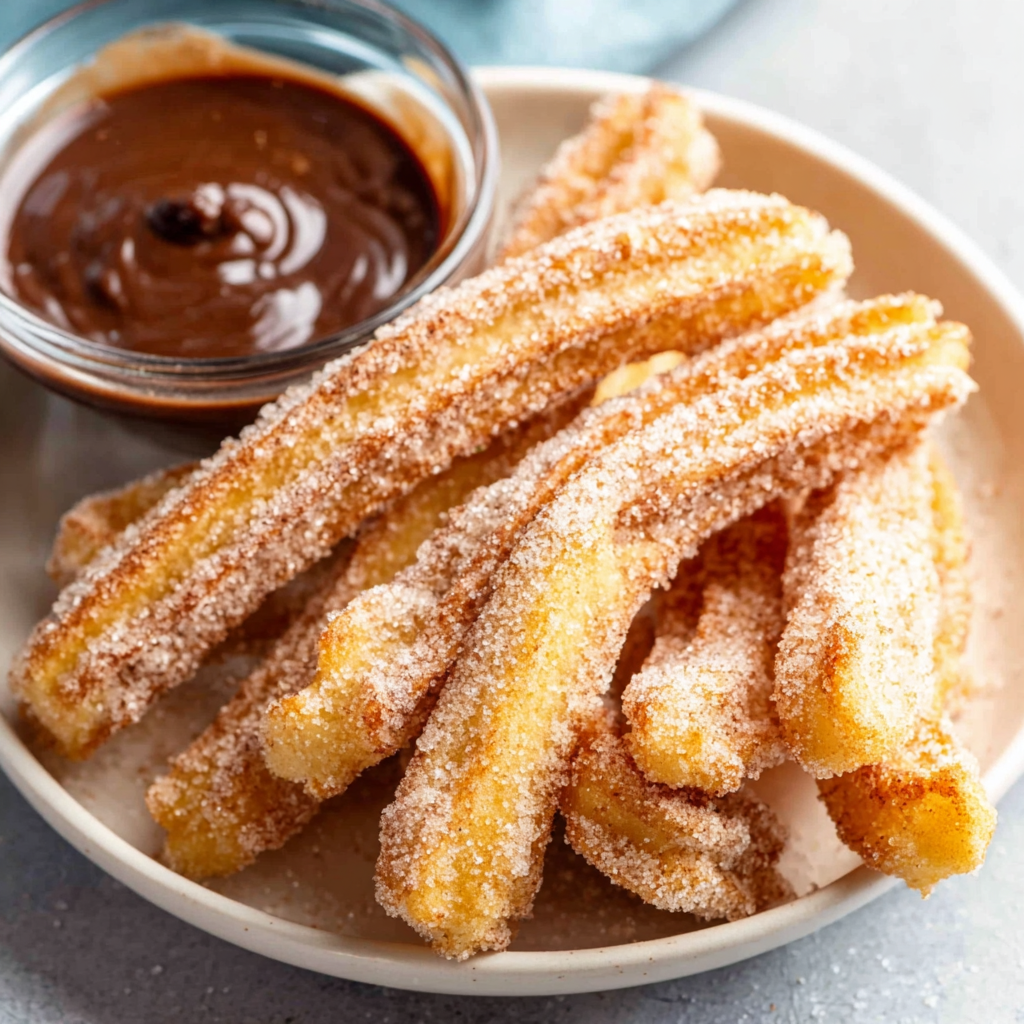Creamy Korean Ssamjang (쌈장) Pasta

Succulent pork belly tossed in a spicy, umami-rich ssamjang cream sauce with spaghetti—an easy Korean-inspired weeknight dinner that feels indulgent and familiar.
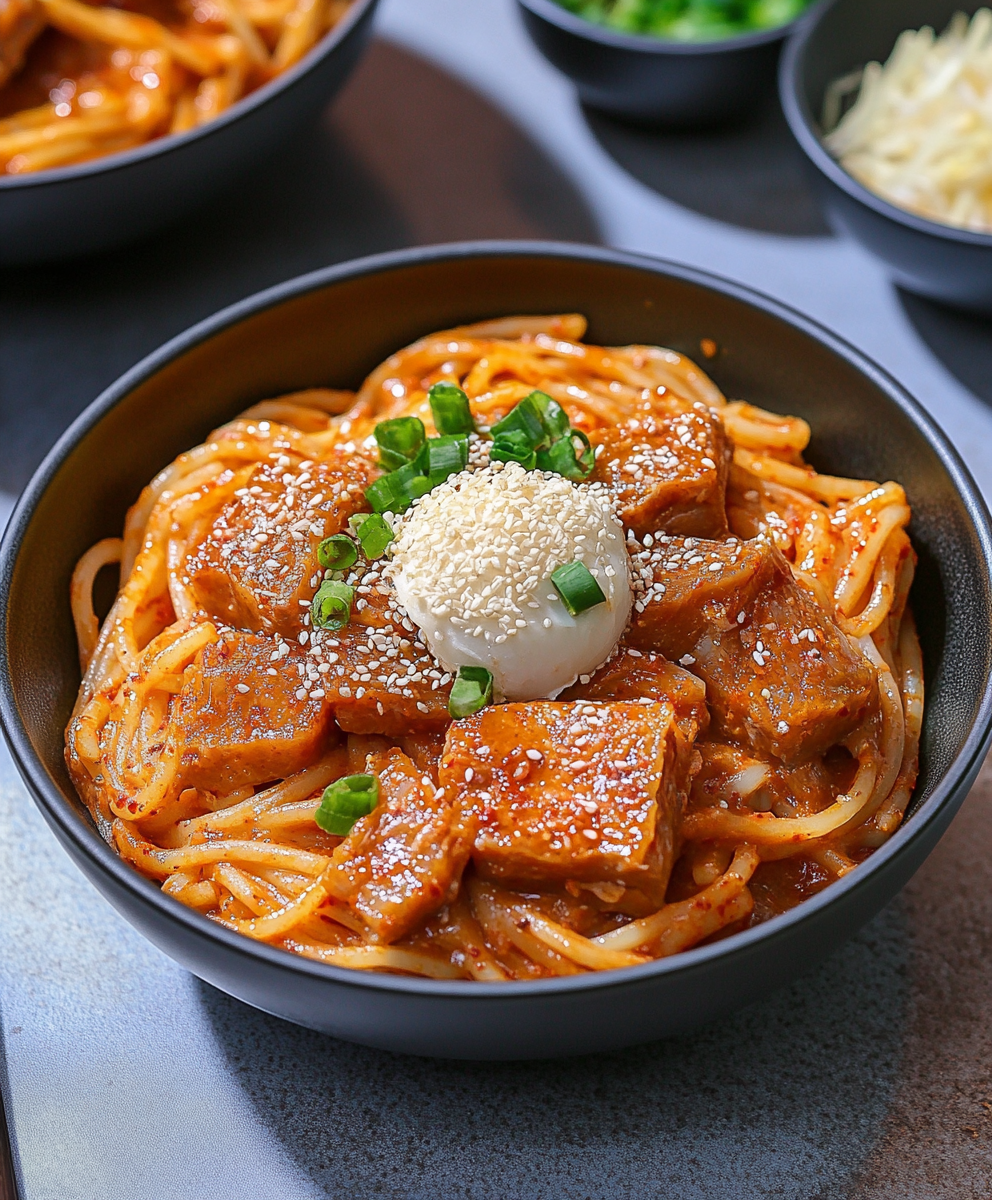
Why You'll Love This Recipe
- This comes together in under 30 minutes, perfect for a quick weeknight dinner when you want something special without a lot of fuss.
- It uses pantry-friendly staples—spaghetti, ssamjang paste, cream, and grated cheese—so you don’t need an elaborate grocery run.
- The pork belly provides a restaurant-level richness; if you want a lighter option, swap in pork shoulder or mushrooms for a vegetarian twist.
- The sauce is highly adaptable: reserve pasta water to control silkiness, and the flavors mature if you let it rest briefly, making it great for make-ahead meals.
- Crowd-pleasing combination—spicy, salty, creamy, and umami-forward—so it’s a hit with adventurous eaters and comfort-food lovers alike.
- Garnish-driven finish: a soft-boiled egg and scallions instantly elevate presentation and add texture contrasts.
I still laugh at how quickly this became part of our dinner lineup—my partner asked for it three nights in a row the first week I made it. On one cold evening, we layered bites into lettuce leaves and forked the ssamjang pasta alongside kimchi; the marriage of heat, cream, and fermented tang made everyone go quiet with satisfaction. The simplicity and speed keep me coming back; once you master the balance of pasta water and cream, it’s nearly foolproof.
Ingredients
- Spaghetti: 7 oz dry spaghetti—choose a high-quality bronze-drawn brand for better sauce cling; thicker strands hold up well to creamy sauces.
- Pork belly: Two slabs (~5 oz total) of pork belly or thinly sliced pork belly pieces—look for a good ratio of fat to meat; extra fat renders into flavor when pan-fried.
- Butter & garlic: 1 tablespoon butter and 1 tablespoon minced garlic—use unsalted butter and fresh garlic for the cleanest flavor; toasted garlic adds sweetness.
- Ssamjang: 3 tablespoons ssamjang paste—the fermented soybean and chili paste is the star, providing umami and spice; brands vary in saltiness, so taste first.
- Parmesan cheese: 1/3 cup finely grated Parmesan plus extra for serving—freshly grated melts smoother than pre-grated powders.
- Cream: 3/4 cup heavy cream—gives body and richness; half-and-half will thin the sauce slightly but is an acceptable swap in a pinch.
- Seasonings: Black pepper and red pepper flakes to taste, salt as needed; reserve pasta water to adjust sauce texture.
- Optional garnishes: Sliced green onions, soft-boiled egg, extra Parmesan, and kimchi for acidity and crunch.
Instructions
Pan-fry pork belly: Start with a cold pan over medium heat so the pork fat renders slowly. Place pork belly slabs skin-side down if present and cook 6–8 minutes per side until golden and crisp on the edges and fully cooked through. Transfer to a plate and roughly chop into bite-sized pieces. Lightly season with a pinch of salt—remember ssamjang is salty, so go easy. Boil the pasta: Bring a large pot of water to a rolling boil, add a generous pinch of salt, and cook the spaghetti until just shy of al dente (check 1–2 minutes before package direction). Reserve about 1 cup of the starchy cooking water before draining—this is the secret to a silky sauce. Make the ssamjang cream: While the pasta cooks, melt 1 tablespoon butter in a medium skillet over medium heat. Add 1 tablespoon minced garlic and sauté 30–45 seconds until fragrant but not browned. Reduce heat to medium-low and add 3 tablespoons ssamjang, stirring to combine. Pour in 3/4 cup heavy cream and bring to a gentle simmer. Cook 2–3 minutes, stirring, so the paste disperses and the cream reduces slightly. Combine pork and sauce: Add the chopped pork belly back to the pan to reheat and infuse the sauce with rendered fat. Stir in 1/3 cup grated Parmesan until melted. The sauce should be thick but loose enough to coat pasta; if it’s too thick, add reserved pasta water gradually. Toss pasta to finish: Add drained pasta directly to the skillet and toss vigorously over low heat. Sprinkle in cracked black pepper and red pepper flakes to your liking. Slowly add reserved pasta water a few tablespoons at a time while tossing until the sauce becomes glossy and silkily coats each strand. Taste and adjust salt if necessary. Plate and garnish: Divide pasta between plates, top with extra Parmesan, sliced green onions, and a soft-boiled egg for richness. Serve immediately with a side of kimchi for acidity and texture contrast.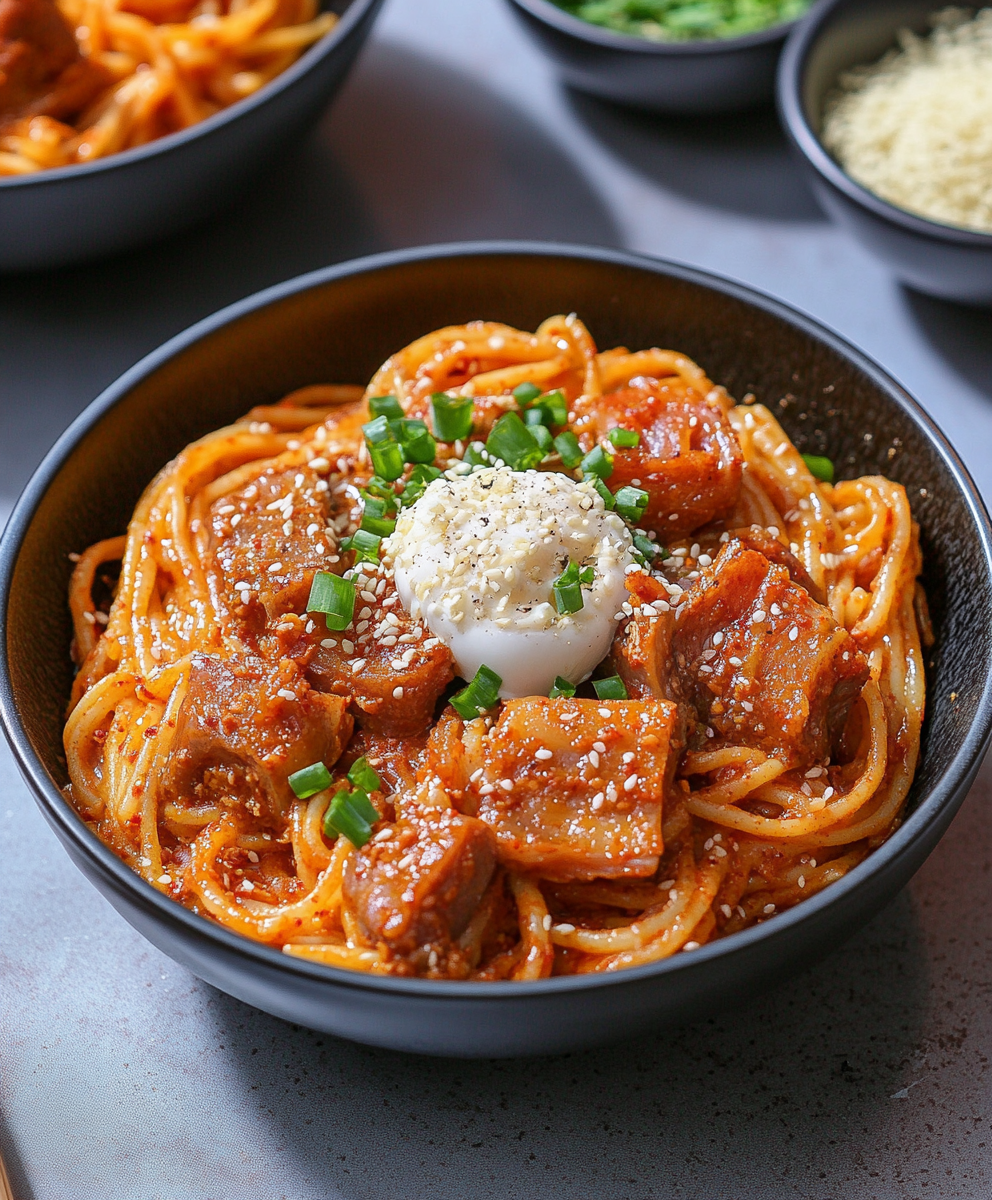
You Must Know
- This dish is calorie-dense and rich—best enjoyed as an occasional indulgence or shared between two with a bright side salad.
- Leftovers keep well refrigerated for up to 2 days; texture will firm up because of the cream, so reheat gently with a splash of water or extra cream to revive silkiness.
- Because ssamjang varies in saltiness, add salt at the end after tasting; a little lemon juice or kimchi juice brightens overly rich versions.
- Reserving at least 1 cup of pasta water is essential—starchy water emulsifies the cream and cheese into a glossy sauce rather than a curdled mess.
- This is not gluten-free unless you use gluten-free spaghetti and verify the ssamjang brand’s gluten status.
My favorite thing about this plate is the contrast: crisp pork belly, creamy sauce, and that pop of kimchi or scallion freshness. Once, at a small family dinner, I swapped the pork for leftover grilled tofu and added a splash of soy to the sauce—surprisingly delightful and proof this template is flexible. The sensory memory of the ssamjang’s fermented depth is what keeps people coming back, and the technique of slowly emulsifying with pasta water is what makes it feel like a restaurant-quality finish.
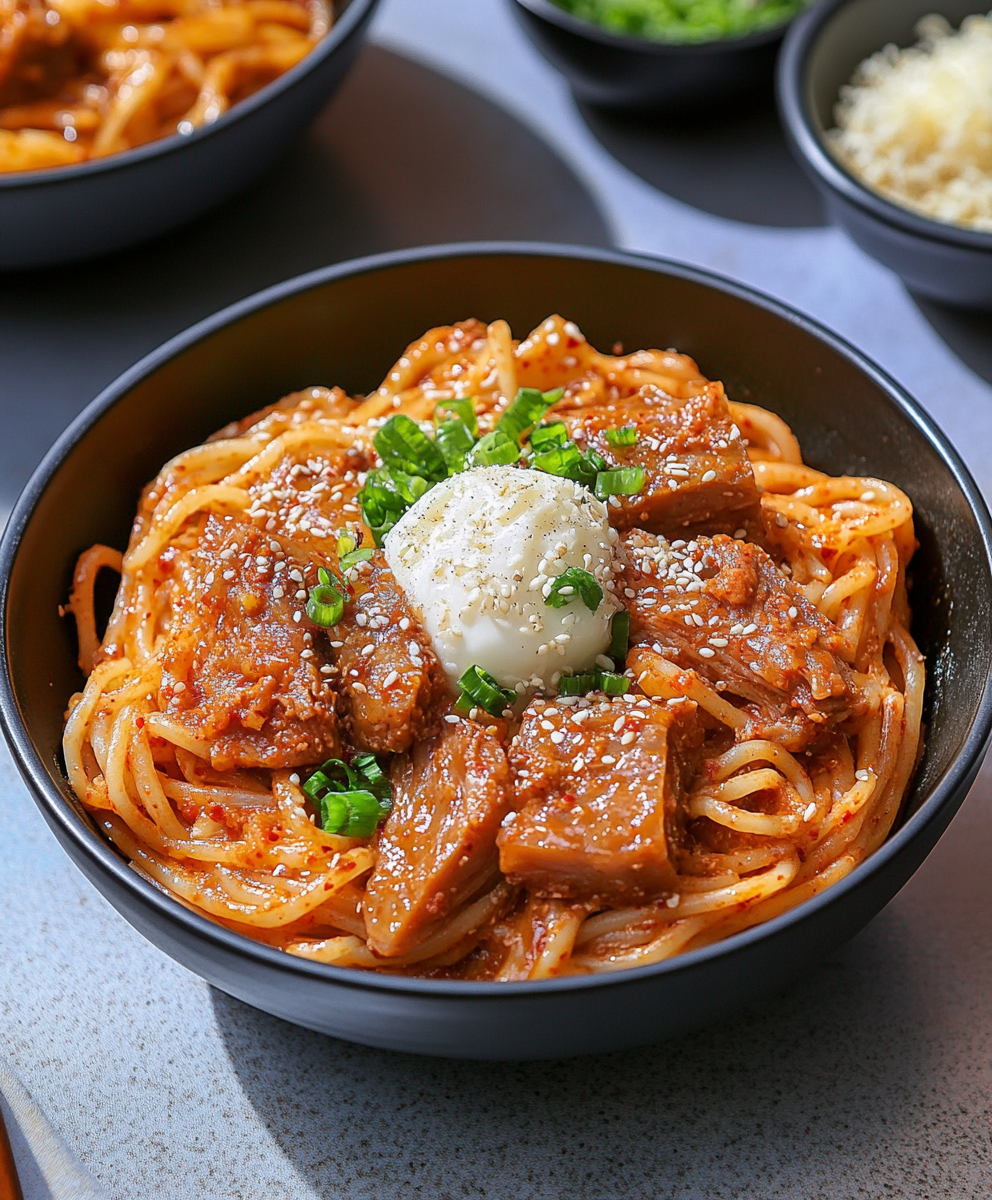
Storage Tips
Store cooled leftovers in an airtight container in the refrigerator for up to 48 hours; fat solidifies and the sauce will thicken. To reheat, place the pasta in a skillet over low heat with 1–2 tablespoons of water or cream and toss until warmed through—this method prevents separation. For longer storage, freeze portions without the egg and green onion in freezer-safe containers for up to 3 months; thaw overnight in the fridge before gently reheating. Look for visual cues: if the sauce separates or develops an off odor, discard.
Ingredient Substitutions
If pork belly isn’t available, use thinly sliced pork shoulder, pancetta, or smoked bacon for a similar fatty hit—reduce added salt if using cured alternatives. For a vegetarian option, swap the pork for thick-cut king oyster mushrooms, sliced and seared until golden; add a tablespoon of miso to deepen umami. If heavy cream isn’t on hand, use whole milk plus 2 tablespoons of butter to approximate richness, or use half-and-half for a lighter sauce. Adjust ssamjang amount to taste; start with less if you’re unfamiliar with its potency.
Serving Suggestions
Serve with a crisp green salad dressed simply with rice vinegar and sesame oil to cut richness. Offer kimchi or quick-pickled cucumbers on the side for acidity. For a shareable dinner, plate the pasta family-style and set out bowls of sliced scallions, extra Parmesan, red pepper flakes, and soft-boiled eggs so guests can customize. This dish pairs well with a cold lager or a dry Riesling to balance the cream and spice.
Cultural Background
Ssamjang is a traditional Korean seasoned paste made from doenjang (fermented soybean paste) and gochujang (chili paste), often used as a dipping condiment for grilled meats and lettuce wraps (ssam). This adaptation takes that familiar ssamjang profile and melds it with Italian technique—emulsifying cheese and pasta water into a cream-based sauce—creating a fusion that honors both cuisines. It’s a contemporary take often seen where home cooks borrow pantry staples across traditions to create comforting, cross-cultural dishes.
Seasonal Adaptations
In spring, lift the plate with blanched asparagus or peas tossed in at the end for a bright, seasonal touch. In summer, add raw cherry tomatoes and basil for freshness; in fall and winter, fold in roasted squash or wilted kale to add body and seasonal depth. For holidays, swap pork belly for roasted pork shoulder and increase the quantity to feed a crowd—finish with a scattering of toasted sesame seeds for a festive crunch.
Meal Prep Tips
Cook components ahead: pan-fry the pork and refrigerate for up to 2 days; keep sauce base in a jar for quick assembly. When meal prepping multiple portions, store pasta separately from the sauce to avoid mushiness; reheat each and combine just before serving. Soft-boiled eggs are an easy make-ahead garnish—cook, cool in ice water, and store peeled in the fridge for 48 hours. Use shallow containers for even cooling and faster reheating.
This creamy ssamjang pasta is an invitation to play with textures and bold flavors—try it once and you’ll understand why that barbecue memory translated so well to a bowl. Make it your own, and don’t be afraid to tweak the heat and salt to suit your pantry and palate.
Pro Tips
Reserve at least 1 cup of pasta water; add it gradually to achieve a glossy, silky sauce.
Pan-fry pork belly starting in a cold pan to render fat slowly and achieve crisp edges.
Always taste ssamjang before adding salt—it varies widely in saltiness between brands.
Toss pasta vigorously in the sauce over low heat to emulsify cheese, cream, and pasta water.
This nourishing creamy korean ssamjang (쌈장) pasta recipe is sure to be a staple in your kitchen. Enjoy every moist, high protein slice — it is perfect for breakfast or as a wholesome snack any time.
FAQs about Recipes
How long does this keep in the fridge?
Yes—store leftovers in an airtight container in the fridge for up to 48 hours and reheat gently in a skillet with a splash of water or cream.
Can I make this lighter?
If you want less richness, use half-and-half instead of heavy cream and reduce the pork or swap it for mushrooms.
Tags
Creamy Korean Ssamjang (쌈장) Pasta
This Creamy Korean Ssamjang (쌈장) Pasta recipe makes perfectly juicy, tender, and flavorful steak every time! Serve with potatoes and a side salad for an unforgettable dinner in under 30 minutes.

Ingredients
Pasta
Pork
Sauce
Garnish
Instructions
Pan-fry pork belly
Place pork belly in a cold skillet over medium heat and cook 6–8 minutes per side until golden and crisp. Transfer to a plate and chop into bite-sized pieces; lightly season with a pinch of salt.
Boil the spaghetti
Bring a large pot of water to a boil, salt generously, and cook 7 oz spaghetti until just shy of al dente. Reserve 1 cup of pasta water, then drain.
Make the ssamjang cream sauce
Melt 1 tablespoon butter over medium heat, sauté 1 tablespoon minced garlic 30–45 seconds, add 3 tablespoons ssamjang, then pour in 3/4 cup heavy cream. Simmer 2–3 minutes to combine flavors.
Combine pork and sauce
Return chopped pork belly to the skillet to reheat and infuse the sauce with rendered fat. Stir in 1/3 cup grated Parmesan until melted.
Finish with pasta water and toss
Add drained spaghetti to the skillet and toss. Gradually add reserved pasta water a few tablespoons at a time while tossing until the sauce is glossy and coats the pasta. Season with black pepper and red pepper flakes.
Plate and garnish
Divide between bowls, top with extra Parmesan, sliced green onions, and a soft-boiled egg. Serve immediately with kimchi on the side.
Last Step: Please leave a rating and comment letting us know how you liked this recipe! This helps our business to thrive and continue providing free, high-quality recipes for you.
Nutrition
Did You Make This?
Leave a comment & rating below or tag
@sararecipes on social media!

Categories:
You might also like...
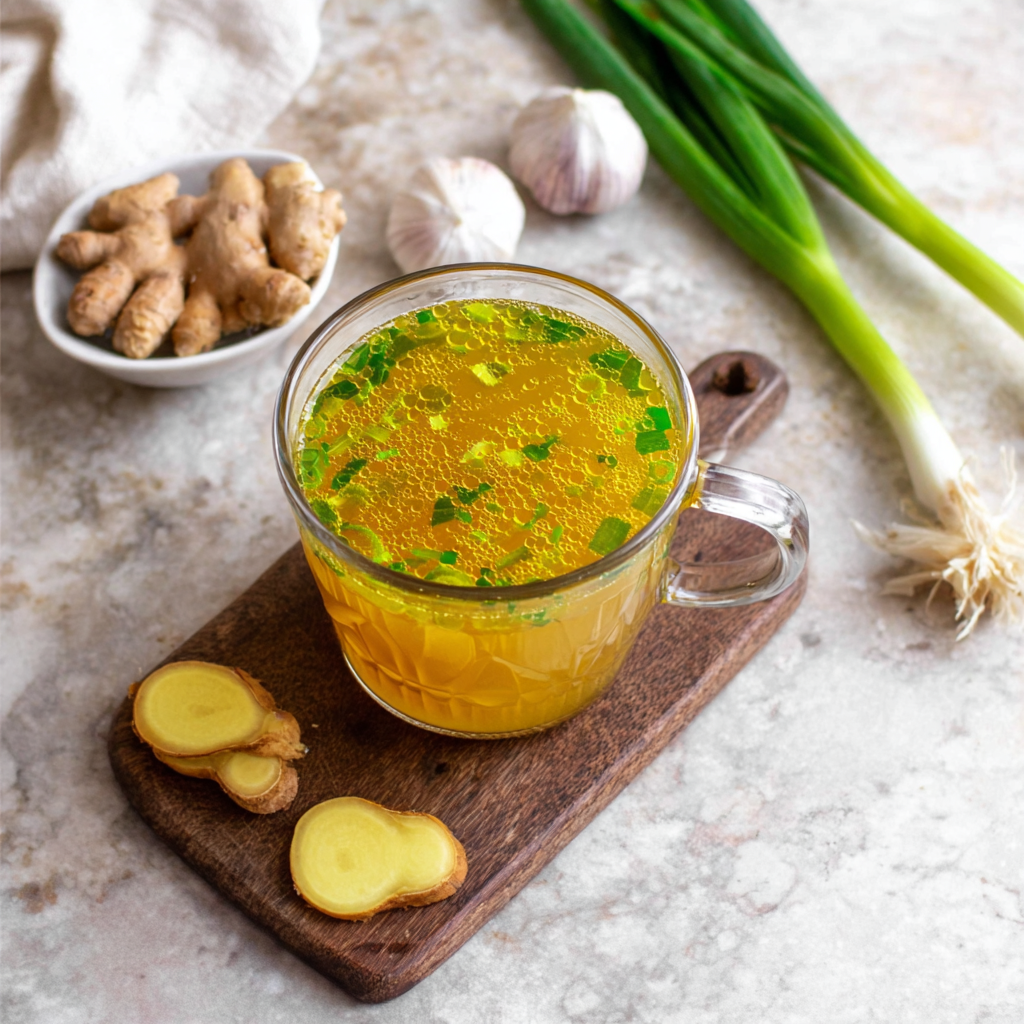
10 Minute Immune Boosting Broth
A bright, restorative broth ready in ten minutes—packed with garlic, ginger, miso and turmeric to support immunity and soothe the soul.
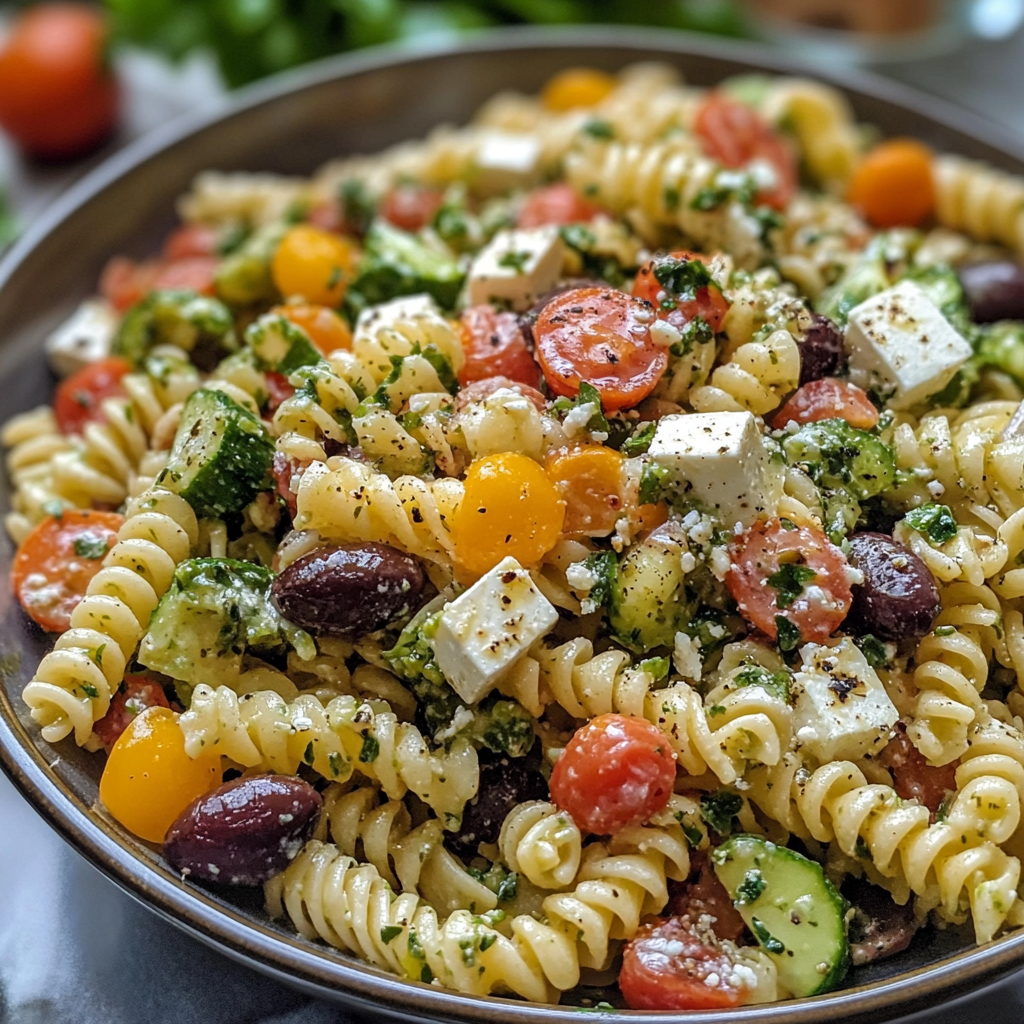
20-Minute Greek Pasta Salad
A bright, 20-minute Greek pasta salad loaded with crisp cucumber, cherry tomatoes, Kalamata olives, feta, and a tangy tzatziki vinaigrette — perfect for summer gatherings or easy meal prep.

Air Fryer Bang Bang Salmon Bites
Crispy-tender salmon bites tossed in a creamy, sweet-spicy bang bang sauce — ready in about 20 minutes using an air fryer or oven.

Did You Make This?
Leave a comment & rating below or tag @sararecipes on social media!
Rate This Recipe
Share This Recipe
Enjoyed this recipe? Share it with friends and family, and don't forget to leave a review!
Comments (1)
This recipe looks amazing! Can't wait to try it.
Comments are stored locally in your browser. Server comments are displayed alongside your local comments.
Hi, I'm Sara!
What's Popular
30-Minute Meals!
Join to receive our email series which contains a round-up of some of our quick and easy family favorite recipes.

